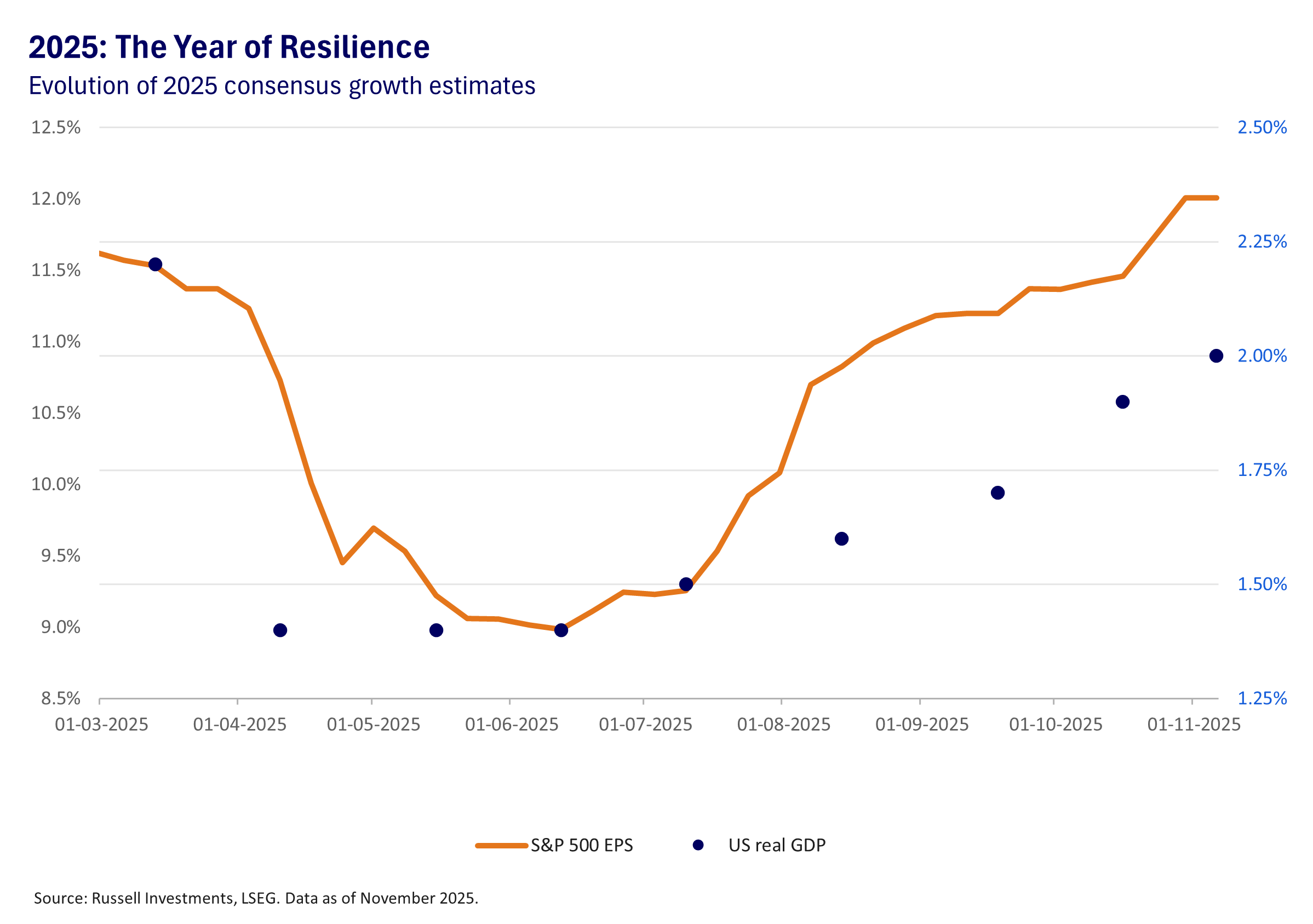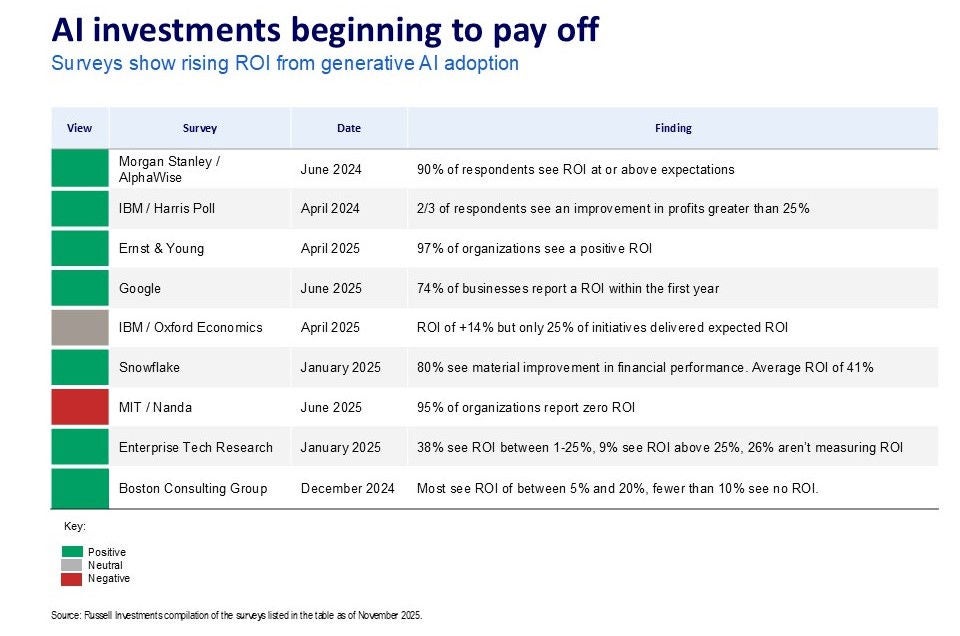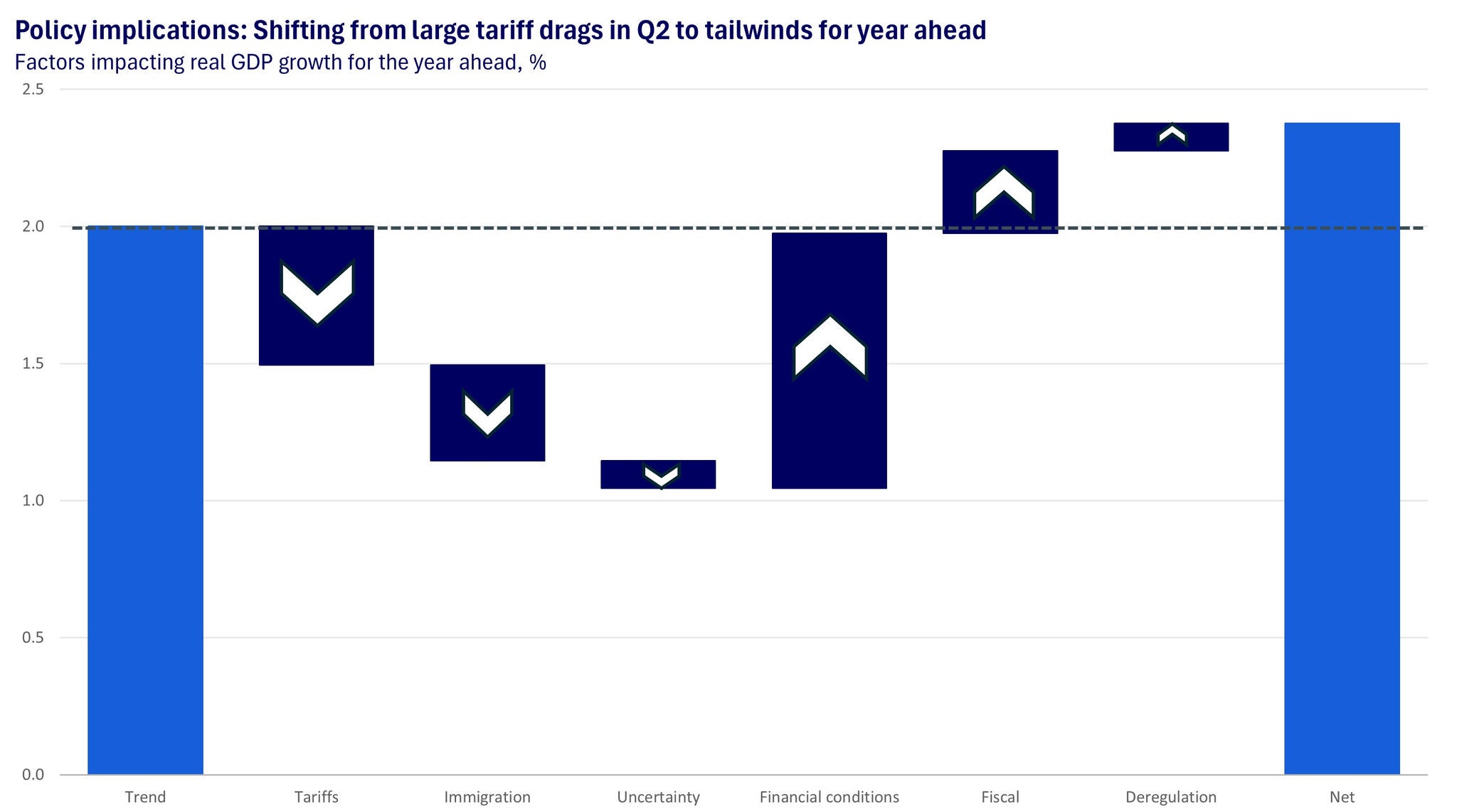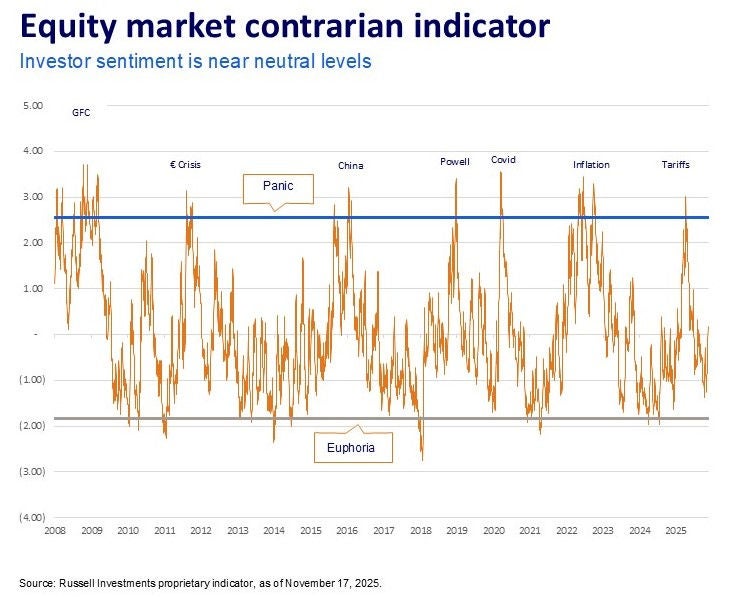2026 Global Market Outlook
The Great Inflection Point
2025년 상반기는 관세 충격이 시장의 핵심 이슈로 부각된 시기였습니다. 투자자들은 올해 수많은 정책 변화에 직면했습니다. 구체적으로 지난 4월 미국 트럼프 대통령은 이른바 ‘해방의 날’이라며 1930년대 이후 최대 규모의 상호관세를 발표했습니다. 또한 1950년대 이후 가장 강력한 미국 이민 제한 조치, 1980년대 이후 가장 야심 찬 규제 완화 정책, 그리고 미국과 독일에서 경기 부양책이 시행되었습니다.
그러나 이러한 혼란 속에서도 시장은 적응해 나갔습니다. 전 세계 대부분의 증시가 4월 저점에서 극적으로 반등하며 연말 사상 최고치 부근에서 거래될 정도로 회복탄력성은 2025년 시장의 핵심 키워드로 부상했습니다. 경제 및 순익 성장률 컨센서스 등 경제 펀더멘털은 상대적으로 낙관적이었던 당사의 전망마저 뛰어넘었으며, 덕분에 시장은 ‘해방의 날’ 이후 하락분을 대부분 회복했습니다.

이러한 회복탄력성은 이제 새로운 국면, 즉 중대한 변곡점으로 이어지고 있습니다. 2025년의 정책발 충격은 시장 시스템을 시험했을지 모르나, 동시에 기술, 성장 역학, 글로벌 자본 흐름의 심층적 변화를 가속화했습니다. 거시 경제 환경이 안정화됨에 따라 시장은 더 이상 정책 충격에 반응하는 국면이 아니라 향후 전개를 대비해 포지션을 재조정하는 단계로 이동하고 있습니다.
당사는 2026년 이후까지 투자 환경을 주도할 가능성이 높은 세 가지 변곡점에 대해 살펴보겠습니다. 첫째, 인공지능(AI) 도입 속도가 빨라지며 에너지 수요, 생산성, 산업별 수익성을 재편할 전망입니다. 둘째, 관세와 정책 불확실성으로 인한 부담 요인이 완화되고, 금융 여건 완화와 재정 부양에 따른 우호적 요인이 강화되면서 미국 경제가 성장 동력을 회복할 가능성이 높습니다. 셋째, 자본이 차세대 글로벌 성장을 이끌 새로운 주도 분야로 이동함에 따라 수익률 격차가 확대되며 투자 기회가 커질 것으로 예상됩니다.
기계 시대의 도래: 생산성 혁명
2026년에는 생성형 AI 도입이 가속화될 전망입니다. AI 통합의 다음 단계는 지금까지 대부분의 활동이 집중되던 기술 분야를 훨씬 넘어서는 범위로 확장될 것입니다. AI 기술이 다양한 직무를 보완함에 따라 이러한 변화는 거시적 차원에서 노동 수요와 성장 역학을 재편할 수 있습니다. 기업 차원에서는 새로운 AI 역량을 얼마나 효과적으로 통합하고 확장하느냐에 따라 성과 차이가 더욱 확대될 가능성이 높습니다.
현재까지 AI 도입으로 인한 대규모 인력 감축의 뚜렷한 조짐은 관측되지 않는 반면, 기업들은 신기술을 활용해 기존 인력의 역량과 생산성을 강화하는 데서 성과를 내고 있는 것으로 보입니다. 이는 결과적으로 ‘동일한 인력으로 더 많은 성과를 창출’하는 방향에 해당합니다. 일부 학술 연구에 따르면, 엔지니어링, 고객 서비스 등 AI 기술로 일정 부분 직무 대체가 가능한 직종에서는 신규 채용이 위축되는 것으로 나타났습니다. AI가 단순한 기술 분야를 넘어 광범위한 부문에서 채택됨에 따라, 새로운 노동 및 생산성 역학이 경제 성장과 기업 성과에 보다 중요한 영향을 미칠 것으로 예상됩니다.
경제 전반에 미치는 생산성과 수익성 개선 효과는 2026년에 더 가속화될 것으로 예상됩니다. 주목할 점은 신기술의 생산성 주기는 보통 초기 마이너스 결과를 내다가 장기적 이익으로 선회하는 ‘J자 곡선’ 패턴을 보인다는 사실입니다. 즉, 기업들은 새로운 시스템을 구매하고 이를 효과적으로 활용할 수 있는 방안을 실험하는 과정에서 초기 비용을 부담해야 하고, 근로자들은 새로운 업무 방식을 익혀야 합니다. 현재 그 과정에서 우리는 어느 단계에 와 있을까요? 컨설턴트, 하이퍼스케일러, 자산 운용사를 대상으로 실시한 설문조사에 따르면, 생성형 AI를 도입한 기업들이 플러스 투자수익률(ROI·Return on Investment)을 내기 시작한 것으로 나타났습니다.

이는 두 가지 측면에서 긍정적인 의미를 갖습니다. 첫째, 이로 인해 AI 투자와 기술 도입 추세가 지속될 가능성이 높습니다. 둘째, 이는 AI 도입에 따른 혜택이 AI 개발자들로부터 AI 사용자들에게 확산되기 시작했음을 시사합니다. 즉, 펀더멘털과 우수한 성과에 기반해 수혜 범위가 폭넓게 확산되는 긍정적 흐름을 뒷받침할 수 있습니다.
AI 관련 자본 지출과 데이터 센터 확장은 이미 미국과 중국의 성장에 기여하고 있지만, 동시에 경제와 시장에 중요한 리스크 요인으로도 작용하고 있습니다. 예를 들어, AI 도입 속도가 기존 범용 기술보다 훨씬 빠를 경우 노동시장에 혼란을 초래할 수 있습니다. 또한 오랜 기간 유지되어 온 비즈니스 모델을 뒤흔들 수도 있습니다. 이미 일부 온라인 지식 플랫폼에서 웹 트래픽 기반 수익의 상당한 감소가 보고되는 등, 이러한 변화의 조짐이 감지되고 있습니다. 마지막으로, 인공지능 구축에 필요한 자본 규모는 자금 시장에 부담을 줄 수 있습니다. 현재 이 자본 지출은 대부분 내부 현금 흐름으로 충당되지만, 2030년까지 자금 조달 수요는 1조 달러를 넘어설 수 있습니다.
회복탄력성 다시 생각하기
세계 경제는 전환점에 서 있습니다. 투자자들이 여전히 기술과 정책이 얽힌 복잡한 흐름을 마주하고 있는 가운데, 미국 내에서는 물론 전 세계적으로 성장 동력이 변화하기 시작했습니다. 미국에서는 최근 몇 달간 무역 협정으로 관세율이 안정화되었고, 2025년 상반기 시장 악재로 작용했던 정책 불확실성이 일부 완화되었습니다. 즉, 관세 충격으로 인한 최악의 시기는 지나갔을 수 있습니다. 한편, 주식시장의 강세에 힘입어 형성된 매우 완화적인 금융 여건은 경제 성장을 뒷받침할 가능성이 있으며, 그 효과는 특히 고소득 소비자층에서 두드러질 것으로 보입니다. 악재는 수그러들고 호재가 부각되는 가운데, 당사 분석은 리스크의 무게 중심이 회복탄력성에서 성장 가속화 국면으로 이동하고 있음을 시사합니다. 2026년 실질 GDP 성장률은 추세를 상회하는 2.25%~2.5% 수준에 이를 가능성이 있습니다.

출처: Russell Investments.
2025년의 강한 회복탄력성에 이어, 향후에도 견조한 펀더멘털을 기반으로 기업 실적 개선 흐름이 지속되고 대규모 인력 감축 국면으로의 진입은 제한적일 것으로 전망합니다. 이 전망에서 주요 리스크 요인은 고용 위축이지만, 최근 일자리 증가 감소분의 85%는 이민 제한과 정부 고용 축소에서 비롯된 것으로 추정됩니다. 즉, 경기 둔화는 주로 정부 정책에서 기인한 것이지 경기 순환적 약세의 증상이 아니라고 판단합니다. 당사의 경제 전망이 맞다면, 최근 고용 시장 경색을 완화하기 위해 금리를 인하한 미 연준(연방준비제도·Fed)은 2026년 초까지 통화정책 완화 주기를 둔화하거나 중단할 가능성이 있습니다. 미 국채 10년물 Yield는 현재 당사의 공정 가치 추정치인 4.1% 근처에서 거래되고 있어, 포트폴리오 내 듀레이션 리스크에 대한 전략적 자산 배분에 부합합니다.
미국 외 지역에서는 유럽 경제가 양호한 흐름을 이어가고 있습니다. 인플레이션은 2% 목표치 부근에서 안정적으로 움직이고 있으며, 노동시장은 건전하고 균형을 유지하고 있습니다. 유럽중앙은행(ECB)의 기준 금리는 정상 수준이고, 경제 성장률도 안정적입니다. 유로존의 주요 관전 포인트는 독일이 재정 부양책의 일환으로 발표한 국방·인프라 투자 공약의 구체화입니다. 일부 추정치에 따르면 이는 내년 유럽 최대 경제국인 독일의 성장률을 두 배로 끌어올릴 수 있는 것으로 나타났습니다.
한편 이머징 마켓 경제는 혼조세를 보이고 있으며, 중국은 단기적으로 정부 목표치인 5%에 근접한 연간 성장률을 달성할 것으로 전망됩니다. 이머징 마켓 지역의 기업 실적 호조는 가장 고무적인 요인입니다. 중국 IT 대기업 주도 하의 상당한 실적 개선 사이클이 진행되고 있으며, 이미 성과를 내고 있는 한국의 구조 개혁 프로그램도 긍정적입니다. 당사는 2026년 글로벌 주식 전략에서 여전히 이머징 마켓을 선호하며 비중 확대 포지션을 유지할 계획입니다.
전면적인 리밸런싱
AI 기반 성과로 뒷받침된 성장과 수익성의 확장은 시장 주도권이 미국 하이퍼스케일러를 넘어 확산되는 전환점을 시사합니다. 향후 종목 간 수익률 격차는 더 확대될 전망인 만큼, 선별적 포지셔닝을 위한 새로운 기회가 될 수 있을 것입니다.
주가가 사상 최고치 근처에서 거래되고 과거 대비 밸류에이션 배수가 높은 상황이지만, S&P 500에 대한 당사의 독자적인 시장 센티먼트 지표는 포트폴리오에서 보다 신중한 전술적 포지션을 요구할 정도의 과열 신호를 보이지 않고 있습니다. 이러한 센티먼트 수준에서는 향후 1년간 주식이 채권 대비 정상적인 차이로 더 나은 수익률을 낼 것으로 예상됩니다. 개인 및 기관 투자자들은 리스크 수준을 전략적 목표치 근방으로 유지한 채 투자 포지션을 유지해야 한다고 판단합니다.

글로벌 기업들의 펀더멘털이 개선되고 무역 가중 미 달러 약세 가능성이 높아지는 상황에서 글로벌 분산 투자의 필요성이 커지고 있습니다. 특히 이머징 마켓은 액티브 운용이 빛을 발할 잠재적 기회 영역 중 하나입니다.
미 국채는 Yield 곡선 전체에 걸쳐 공정 가치 추정치 근처에서 거래되고 있어, 채권 및 다중 자산 포트폴리오상 전략적인 듀레이션 할당이 적절하다고 판단합니다. 동시에 공모시장 신용 스프레드는 과거에 비해 타이트한 수준이며, 전문 매니저들은 주식, 증권화 신용, 그리고 공모시장에 비해 수익률이 상당히 유리한 사모시장 채권 비중을 늘릴 기회를 모색하고 있습니다.
또한 장기적 측면에서 지정학적 리스크 고조, 공급망 회복탄력성, 사상 최고 수준의 막대한 정부 부채를 고려할 때 포트폴리오의 회복탄력성을 강화하고, 실물 자산, 사모시장, 새로운 대체 자산 등으로 투자를 다각화해야 할 것입니다.
투자자 시사점
2026년을 맞이하는 현 시점에서 당사는 경기 침체보다는 경제의 회복탄력성과 활성화에 무게 중심을 두고 포지션을 구축하고 있습니다. 당사는 투자 포지션을 유지하면서 종목 간 수익률 격차가 큰 시장에서 가치를 창출할 종목 선별에 주력하는 한편, 다양한 자산군에 걸쳐 포트폴리오 수익률을 견인할 핵심 동인을 발굴하고 있습니다.
주식시장 전망
작성자: Will Pearce, Megan Roach, Pierre Dongo-Soria
공모·사모시장 전반에서 나타나는 주도주 확대
펀더멘털이 강화되고 주도 종목이 확대되면서 주식시장은 새로운 성장 국면으로 진입하고 있습니다. 다음 단계 AI 투자 사이클에 대한 기대감과 보다 균형 잡힌 글로벌 환경에 대한 낙관론이 맞물리며 상장 자산과 사모 자산에 훈풍이 예상됩니다. 자산 간 수익률 격차가 커지며 상장 및 사모시장 전반에 걸쳐 가치 창출을 위한 액티브 매니저의 전문성이 중요해지는 시기입니다.
핵심 요점
- AI 도입이 초기 ‘개발자’ 단계에서 광범위한 ‘사용자’ 단계로 전환되면서 시장 주도 종목이 확대되고 있습니다.
- 유럽, 일본, 이머징 마켓 전반에 걸쳐 시장의 폭(market breadth·상승 종목과 하락 종목의 비율)이 개선되고 있습니다.
- 액티브 매니저들은 밸류에이션 갭과 종목 간 수익률 격차 확대를 고려해 기회를 포착하고 있습니다.
- 사모 펀드와 벤처캐피털은 AI 기반 차세대 기회를 선점하고자 움직이고 있습니다.
자본 흐름과 새로운 AI 단계
주식시장의 결정적 동력은 여전히 AI 인프라 확장이지만 그 영향력은 변화하고 있습니다. 하이퍼스케일러와 반도체 기업이 주도한 초기 인프라 사이클이 이제 더 폭넓은 기업 채택으로 확산되고 있습니다. AI를 활용해 생산성과 영업이익률을 높이는 기업들이 차세대 수혜자로 부상하고 있습니다.
이러한 변화는 글로벌 주식 시장의 성과를 좌우하고 있습니다. 미국 초대형주의 영향력은 지속되겠지만, AI 인프라 및 도입에서 비롯된 투자 동력이 이제 미국 이외 지역과 중견 혁신 기업까지로 확산되고 있습니다. 이를 주식시장에 대입해 본다면, 그간 몇몇 선도 기업에 쏠렸던 자금이 실적과 운영 효율성이 뛰어난 부문으로 좀 더 폭넓게 확산될 수 있음을 의미합니다.
매니저들은 이러한 확대 국면을 종목 선별을 통해 차별화된 성과를 추구할 기회로 보고 있습니다. 펀더멘털은 개선되고 있으나 기업 가치평가의 편차가 큰 환경에서, 종목 간 격차가 확대될수록 규율 있는 액티브 운용의 중요성은 더욱 부각될 것으로 판단됩니다.
글로벌 저변 확대와 액티브 운용 기회
주가 밸류에이션은 전반적으로 여전히 높은 편이지만, 랠리에 동참하는 종목 수는 늘고 있습니다. 유럽과 일본은 정책 개혁과 재정적 모멘텀의 혜택을 계속 누리고 있으며, 아시아의 주요 기술 및 산업 기업들은 앞다투어 실적을 상향 조정하고 있습니다. 우리는 이머징 마켓 기술주부터 유럽의 경기 민감주, 효율성 개선을 위해 AI를 도입하는 미국 기업에 이르기까지, 펀더멘털이 개선되고 있음에도 주가가 여전히 합리적인 수준에서 거래되는 종목들이 특히 매력적이라고 생각합니다.
종목 간 수익률 격차가 다시 확대되는 이와 같은 상황은 액티브 방식의 운용에 유리합니다. 포트폴리오 매니저들은 다각화된 종목 선정, 가치주와 우량주에 대한 신중한 비중 확대, 중·소형주에 대한 선별적 노출을 중시하고 있습니다. 운용팀들이 지속 가능한 수익성과 균형 잡힌 지역별 익스포저에 집중함에 따라 High Momentum 종목에 대해서는 여전히 비중 축소 포지션을 유지하고 있습니다. 당사 플랫폼 전반에 걸쳐 매니저들은 현재 사이클에서는 펀더멘털이 밸류에이션보다 빠르게 개선되는 곳에 자본을 투입하는 정밀 투자가 유리하다고 강조합니다.
Growth 및 Value 팩터 매니저들은 모두 AI 발전에 맞춰 접근방식을 조정하고 있습니다. Growth 팩터 위주의 팀은 실질적인 생산성 향상과 확장 가능한 수익 레버리지를 보여주는 기업에 집중하고 있습니다. 반면 Value 팩터 매니저들은 AI를 점진적으로 도입하며 펀더멘털과 가격 결정력이 개선되는 종목에서 기회를 찾고 있습니다. 이러한 스타일적 균형은 액티브 포트폴리오 내에서 질적·지속가능성 측면으로의 체계적인 전환을 반영합니다.
함께 진화하는 사모시장
공모시장과 함께 사모 자본도 진화하고 있습니다. AI 인프라 붐은 데이터 센터, 자동화, 에너지 전환 기술 분야에서 새로운 투자 기회를 창출하고 있습니다. 벤처 및 성장 주식 투자자들은 상장된 선도 기업과 인접한 혁신 분야를 목표로 삼고 있으며, 사모펀드 매니저들은 미국 초대형주를 넘어 시장 주도 범위가 확대됨에 따라 개선된 투자 회수 환경을 마주하고 있습니다.
밸류에이션이 재조정될 경우, 장기 사모 투자자들은 원칙에 기반한 투자 진입 시점을 맞이할 수 있습니다. 많은 매니저들이 지금을 사모 자산 익스포저를 상장 시장 테마와 연계할 수 있는 건설적 시기로 보고, 사모 자산이 갖는 보완적 역할을 활용해 차세대 혁신과 성장의 물결에 올라탈 것을 강조합니다.
투자자 시사점
주식시장은 성장률 호전, 수익률 격차 확대, 지역·스타일·자산군 전반에 걸친 주도주 확산을 특징으로 하는 새로운 국면으로 전환되고 있습니다. 이러한 환경에서 투자자들은 균형 잡힌 접근방법을 취하는 것이 좋습니다. 즉, 우량주 위주의 다각화된 주식 포트폴리오에 더해 구조적 혁신을 활용할 수 있도록 포지셔닝된 사모 및 성장 단계 전략으로 보완하는 방식입니다.
당사의 관점에서 수익률 격차에 대응하고 공모·사모시장 전반에 걸쳐 가치 창출의 다음 단계가 도래할 지점을 식별하는 데 있어 액티브 운용은 여전히 핵심적 역할을 담당합니다.
공모 및 사모 투자 기회를 아우르는 통찰력을 통합하고, 성장 혁신과 가치 투자 원칙을 균형 있게 조율할 수 있는 매니저들이 변화하는 AI 주도 환경을 포착하는 데 가장 유리한 위치에 있다고 믿습니다.
채권 전망
작성자: Van Luu, Riti Samanta, Keith Brakebill
듀레이션, 채권, 수익률 격차
낮은 정책금리와 재정 여건의 변화가 글로벌 채권 환경을 재편하고 있습니다. 공개 채권 시장과 사모 크레딧 시장은 한 해를 서로 다른 환경에서 출발하겠지만, 2026년 채권 시장의 핵심 키워드는 수익률 격차, 자산 선별, 자산 비중 재조정이 될 가능성이 높습니다.
핵심 요점
- 미국 국채는 공정 가치 수준을 유지하면서, 전략적 듀레이션과 포트폴리오 안정성을 제공합니다.
- 각국의 정책 방향이 엇갈릴 때 상대적 가치 포지셔닝 기회가 열립니다.
- 공모 크레딧 스프레드 축소는 액티브 방식의 증권 선별과 증권화 크레딧 익스포저에 유리합니다.
- 사모 크레딧 및 자산 기반 금융은 구조적 수익률과 포트폴리오 다각화 측면에서 지속적인 강점을 제공합니다.
전환기의 시장
2025년 하반기 정책 금리 하락과 신용 스프레드 축소로 채권 자산은 우수한 성과를 기록했습니다. 인플레이션 압력이 완화되면서 투자자들의 관심은 선진국 시장의 향후 재정 상황에 쏠리고 있습니다.
공개 채권 시장과 사모 채권 시장은 현재 서로 다른 흐름을 보이고 있습니다. 공개 채권 시장에서는 미 연준의 금리 인하 이후 미국 국채가 회복세를 보이고 있습니다. 반면, 사모시장에서는 고금리 장기화 환경이 예상보다 오래 지속되며 장기 투자자들에게 매력적인 기회가 유지되고 있습니다. 공개 채권은 듀레이션과 포트폴리오 다각화 효과를 제공하는 반면, 사모 크레딧은 구조적 수익률을 제공한다는 점에서 두 부문은 상호 보완적인 역할을 수행합니다.
총수익률은 여전히 매력적이라고 판단됩니다. AAA의 투자등급 채권은 10년물 국채 대비 약 50bp의 프리미엄을 제공하며, 상대적으로 신용도가 좋은 하이일드(고수익·고위험) 채권 Yield는 6%를 웃돕니다. 펀더멘털(관리 가능한 레버리지 및 높은 이자 지급 능력)은 여전히 탄탄하며, 발행 규모가 상당함에도 초과 청약이 지속되고 있습니다. 스프레드 축소로 많은 매니저가 미 국채 비중을 높게 유지하고 있으나, 단기 매도세는 선별적 상대가치 투자 기회를 창출했습니다. 서브프라임 차입자들의 스트레스 조짐은 여전히 국한적이고 통제 가능한 수준입니다.
미 달러 약세로 이머징 마켓의 현지 통화 표시 채권이 지지받으며, 2024년 대부분 기간 동안 희박했던 투자 기회가 확대되었습니다. 미 경제 지표 발표 지연 등 정책 및 데이터 불확실성은 다음번 통화 완화 정책에 대한 대응을 모색하는 투자자들이 계속 주시해야 할 사항입니다.
재정 압박과 맞물린 정책 완화
미 연준이 완화적 통화정책 기조로 선회한 것은 글로벌 금리에 있어 명확한 전환점을 시사합니다. 단기채 및 중기채가 가장 큰 수혜를 입었지만, 여타 선진국의 재정 위기 우려로 국가 간 국채 Yield 격차는 또다시 확대되었습니다. 10년물의 경우 영국 국채와 미국 국채는 약 50bp 차이로 거래되는데, 이는 인플레이션과 성장 전망의 차이가 어떻게 투자 기회를 형성할 수 있는지 보여줍니다.
이처럼 완화적 통화정책과 재정 적자 확대에 대한 우려가 맞물리면서 장기 채권 발행이 증가할 것으로 예상되는 가운데, Yield 곡선은 완만한 가파름을 유지할 가능성이 높습니다. 미국 국채는 여전히 공정 가치 수준에 근접해 있어 중립적인 듀레이션 포지션이 적절한 환경으로 판단됩니다. 한편 영국 국채 Yield는 재정 요인에 따른 변동성 이후 상대적으로 매력적인 수준으로 평가되며, 향후 예산 정책의 명확성이 제고될 경우 회복 여지가 있을 것으로 예상됩니다. 전반적으로 채권 시장에서는 정책 완화에 따른 긍정적 요인과 재정 리스크가 동시에 작용하고 있으며, 이러한 긴장 관계가 2026년 채권 시장의 핵심 변수로 부각될 가능성이 큽니다.
신용 시장: 스프레드보다 구조적 요인
공모 크레딧 스프레드는 여전히 역사적 저점 부근에 머물러 있어 추가적인 축소 여지는 제한적인 상황입니다. 당사는 투자 등급 회사채의 경우 밸류에이션에 이미 긍정적 전망이 반영되어 있다고 판단하여 익스포저를 축소했습니다. 반면 실물 자산 담보에 금리 민감도가 낮은 증권화 신용 상품—특히 비정부보증(non-agency) 모기지담보증권(MBS)—은 긍정적으로 판단합니다. 증권화 채권 시장의 약 3분의 1을 차지하는 대출채권담보부 증권(CLO)은 불확실한 금리 환경에 적합한 단기 듀레이션 변동 금리 구조를 제공합니다.
사모 크레딧 시장 역시 여전히 유망한 투자 영역으로 판단됩니다. Yield 이점과 구조적 보호 장치를 바탕으로 자본 유입이 지속되고 있으며, 특히 유형 자산을 담보로 하는 자산 기반 금융(asset-based finance)이 주목받고 있습니다. 또한, AI 기반 기업 투자가 다음 단계로 넘어가며 공모 및 사모 신용 시장 전반에 걸쳐 발행 규모가 확대되고, 복잡성과 구조적 요소에 효과적으로 대응할 수 있는 매니저에게 새로운 기회가 열리고 있습니다.
투자자 시사점
우리는 채권 스펙트럼 양쪽 모두에서 투자 기회를 포착하고 있습니다. 통화정책 완화 기조가 지속되면서 공개 채권 시장은 적정 가치의 듀레이션과 유동성을 제공하고, 사모 시장은 Yield, 분산 투자 효과, 실물 경제 자산에 대한 접근성을 제공합니다.
확대 재정 정책과 이에 따른 국채 발행 확대는 장기 Yield에 완만한 압박을 가할 수 있어, 자산 선별과 액티브 운용의 중요성을 강조합니다. 향후 단계는 단순히 Yield를 추구하기보다는 유동성, 신용 품질, Yield 곡선 익스포저 간의 균형을 맞춤으로써 채권 자산을 통한 포트폴리오 회복탄력성을 높여야 할 것입니다.
실물 자산 전망
작성자: BeiChen Lin, Tim Ryan
인프라, 부동산, AI 구축
강한 회복탄력성을 보여온 글로벌 경제가 본격적인 재가속 국면에 진입함에 따라, 공개 및 사모 실물 자산이 핵심적인 분산 투자 수단으로 부각되고 있습니다. 상장 인프라 및 부동산은 유동성과 시장 접근성을 제공하는 반면, 사모 실물 자산은 지속적인 현금 흐름과 구조적 수익률을 제공하며 인공지능(AI) 및 에너지 전환 인프라 확장 흐름에 대한 직접적인 익스포저를 제공합니다. 전력, 회복탄력성을 갖춘 물류, 방위 관련 인프라에 대한 장기적 수요가 증가함에 따라, 이러한 익스포저는 2026년까지 다중자산 포트폴리오의 한 축이 될 수 있다고 믿습니다.
핵심 요점
- 상장 실물 자산의 밸류에이션은 주식 대비 매력적이지만 국채 대비 매력도는 상대적으로 낮습니다.
- AI, 에너지 전환, 국가 안보는 지속적으로 인프라 수요를 견인할 동인이 될 전망입니다.
- 사모 실물 자산은 수익률과 회복탄력성을, 공모시장은 유동성과 전술적 접근성을 제공한다고 판단합니다.
- 상장 및 사모 전략 전반에 걸쳐 종목 선별과 매니저의 역량은 수익률을 좌우하는 주요 동인으로 작용할 전망입니다.
새로운 거시 경제 국면에서의 포트폴리오 다각화
경기 침체 가능성과 정책 불확실성이 수그러들며 실물 자산이 다시 다각화 전략에 있어 핵심 요소로 자리매김할 전망입니다. 상장 인프라와 리츠는 증시 전반과 비교할 때 여전히 낮은 가격에 거래되고 있어, 상장 자산 내 자금 배분에 있어 상대적으로 매력적인 투자 기회로 보입니다. 동시에 사모 전략은 변동성을 완화하고 장기적인 현금 흐름 성장세를 포착할 수 있습니다. 이런 동향은 상장 시장에 완전히 반영되지 않을 수 있습니다. 우리는 공모시장에 전술적 편향을 두고, 사모시장을 구조적 익스포저로 활용하는 균형 잡힌 접근법을 선호합니다.
인프라: 전력, 에너지 전환, 국방
인프라 투자는 여전히 AI의 부상, 에너지 전환, 국가 안보 투자 확대라는 세 가지 테마가 주도하고 있습니다.
첫째, AI 채택 확산으로 전력 소비량이 증가하면서 이미 한계 근처에 다다른 전력망에 부담이 가중되고 있습니다. 이로 인해 발전, 저장, 배전 시설을 확충하기 위한 몇 년간의 투자 주기가 형성되고 있으며, 이는 곧 상장 유틸리티 기업과 민간 에너지 인프라 부문의 투자 기회를 시사합니다. 둘째, 에너지 전환은 비록 지역별 편차는 있으나 전반적으로 의미 있는 진전을 이루고 있습니다. 유럽의 재생에너지 확대와 전력망 확충 사업이 대표적인 사례입니다. 셋째, 국가 안보 예산이 증가하면서 군 숙소부터 물류 및 안전한 에너지 시설에 이르기까지 국방 관련 인프라로 자본이 재분배되고 있습니다.
에너지 안보와 국방 테마로 점점 더 많은 민간 자본이 유입되고 있습니다. 현재 미국 시장의 경우, 일부 유럽 지역보다 전환 규모가 크고 민간 자본 유입 속도도 빠르기 때문에, 사모 자산 전문 매니저들은 이를 반영해 포트폴리오를 배분하고 있습니다.
부동산 및 사모시장: 자산 선별의 중요성
금리가 인하되면 부동산 부문에 호재이지만, 밸류에이션 매력도는 하위 부문별로 차이가 있습니다. AI 발전으로 인해 하이퍼스케일 데이터센터에 대한 수요는 견조하므로, 이 부문에 대한 긍정적 전망에는 이견이 거의 없습니다. 노인 주거 시설 및 의료·헬스케어 관련 부동산도 고령화에 따른 인구 구조 변화로 수혜가 예상됩니다. 사모시장에서는 매니저들이 약정에 기반한 현금 흐름을 창출하는 필수 자산—유틸리티, 통신 타워, 물류, 특수 산업 시설—에 집중하는 한편, 경기 사이클에 민감한 자산은 피하고 있습니다.
운용사 포트폴리오에서 틈새 상품에 불과하던 방위 관련 및 에너지 안보 자산이 이제 주요 자산으로 부상하고 있으며, 특히 거버넌스와 규제 명확성으로 유럽 투자자들의 관심이 커지고 있습니다. 이러한 모든 요인은 유능한 매니저 선정 및 시장 테마에 얼마나 부합하는지 여부가 성과 창출에 핵심적일 것이라는 관점을 뒷받침합니다.
투자자 시사점
우리는 2026년 포트폴리오 구축의 핵심 구성 요소로 공개 및 사모 실물 자산 모두에 주목하고 있습니다. 상장 실물 자산은 유동성, 가격 발견(price discovery), 가치평가 측면에서 이점을 갖습니다. 비상장 실물 자산은 수익 안정성, 상장 시장과의 낮은 상관관계, AI 인프라, 에너지 안보, 방위 프로젝트 관련 지출에 대한 직접적 익스포저라는 이점을 제공합니다.
투자자들은 공개 및 사모 자산을 균형 있게 배분하는 것을 고려하고, 해당 분야 전문성을 갖춘 매니저를 중시하며, 약정 또는 필수 현금흐름을 보유한 자산을 우선시해야 한다고 봅니다. 특히 사모시장에서는 자금이 좀 더 신속하게 할당되며 특히 미국 방위 산업 및 에너지 안보 분야를 중심으로 매력적인 투자 진입점을 포착할 수 있겠으나, 투자자들은 지역별 규제 요건 및 이행 차이를 염두에 두어야 할 것입니다.
자산군별 선호도
이 개요는 당사의 최신 자산군 전망을 요약합니다. 각 박스를 클릭하면, 당사 견해를 형성하는 데 영향을 미친 기회와 리스크에 대해 자세히 알아볼 수 있습니다.
지역별 스냅샷

미국
정책발 불확실성이 해소되고 완화적 금융 여건, 세제 정책, 규제 완화라는 호재가 강화되면서 미국 경제는 순항할 전망입니다. 기업 순익은 견조한 흐름을 보이며, 긍정적인 경영진 전망 속에 2026년 순익 성장률 컨센서스도 상향되고 있습니다. 펀더멘털이 개선되며 시장 주도주도 확대되고 있습니다. 미 연준은 탄탄한 경제 성장과 고용 위축 상황을 동시에 고려하고 있습니다. 당사의 건설적 전망이 현실화될 경우, 미 연준은 금리 인하를 멈춘 뒤 경제가 재차 과열되면서 2027년을 향해 통화정책 전환(pivot)에 나설 가능성이 높습니다. 미 국채는 당사가 제시한 공정 가치 추정치 근처에서 거래되고 있으며, 기업 신용 스프레드는 과거보다 타이트한 수준입니다. 낙관적인 거시 전망을 흐리게 할 주요 리스크 요인으로는 급격한 고용 시장 악화, 높은 밸류에이션, 최근의 부실 대출 소식이 본격적인 신용 경색으로 확대될 가능성, 대대적인 AI 설비 투자 자금 조달 필요가 시간이 지남에 따라 자금 조달 시장에 압박을 가할 가능성을 꼽을 수 있습니다.

캐나다
캐나다는 9월과 10월 두 달 연속으로 시장 예상치를 크게 상회하는 고용 증가세를 기록했으며, 이는 경기 주기상의 리스크가 정점을 지났음을 시사합니다. 단, 실업률이 여전히 7% 수준으로 향후 12개월 동안 미국보다 경기 침체 위험에 더 취약할 수 있다는 기존 전망을 유지합니다.
캐나다 주식과 관련해서는 미 증시 대비 저렴한 밸류에이션이 경기 사이클상의 역풍을 상쇄할 수 있다고 판단하여 중립 포지션을 유지합니다. 캐나다 국채는 공정 가치에 근접한 수준이나, 여전히 핵심적인 전략적 분산 투자 수단이 될 수 있습니다. 기준금리가 캐나다 중앙은행(BoC)의 중립 금리 추정치 하단에 위치한 상황에서 추가적인 금리 인하 여력은 크지 않습니다. 단, 거시 경제 불확실성이 지속되고 노동시장이 취약해진다면 2026년 추가적인 금리 인하가 단행될 수 있습니다.
캐나다 달러는 단기적으로는 캐나다 경제 약세로 하방 압박을 받기 쉬우나, 중기적으로는 미국 달러 대비 강세를 보일 가능성이 높습니다.

유로존
2026년 유럽 각국의 재정 정책이 엇갈리며 유로존 내 성장률 격차도 확대될 전망입니다. 유로존 최대 경제국인 독일의 국방 및 인프라 지출 확대는 독일 성장률을 끌어올리며, 오스트리아, 벨기에, 네덜란드 등 주요 교역국에도 긍정적인 파급 효과를 미칠 수 있습니다. 한편 프랑스, 이탈리아, 스페인의 긴축 재정으로 인해 2026년 유로존 성장률은 1%를 간신히 넘길 전망입니다. 인플레이션이 목표치에 근접하고 노동시장이 안정된 현 상황에서 유럽중앙은행(ECB)의 정책은 ‘적절’하다고 판단됩니다. 독일 국채는 현재 공정 가치 추정치 근처에서 거래되고 있다고 판단합니다. 유로존 주식에서는 Value 팩터 위주의 익스포저가 선호됩니다.

영국
영국 경제는 최근 몇 달간 경제 활동과 노동시장이 약화되며 여전히 정체 상태에 머물러 있습니다. 2026년의 성장 동력은 재정 정책에서 통화 정책 쪽으로 선회할 가능성이 높습니다. 예산안에 따라 세금 인상이 예상되는데, 이는 2026년 후반부로 갈수록 성장 부담을 가중시킬 것입니다. 인플레이션 위험이 완화됨에 따라 영란은행은 경제 안정화를 위해 기준금리를 3%로 인하할 것으로 예상됩니다. 2026년 영국 국채는 G7 국가 국채 중 선호되는 투자 대상입니다. 영국 증시는 다국적 대기업 비중이 높은 특성상 글로벌 경제 호조세가 반영될 것이므로 영국 경제에 비해 선전하리라 전망합니다.

중국
중국은 부동산 시장 침체에 따른 구조적 문제에 더해 소비 지출 위축 국면이 지속되면서 2026년에도 다소 약한 경제 성장을 기록할 전망입니다. 과도한 내부 경쟁으로 촉발된 디플레이션 압력을 완화하기 위한 ‘반내권(反內卷, anti-involution)’ 접근방식은 정책적 관점에서 주목할 사항입니다. 한 해 동안 선별적 경기 부양책이 시행되겠으나, 경제를 극적으로 활성화시킬 만한 조치는 없을 것으로 예상됩니다. 기준 금리가 인하될 가능성도 있습니다. 중국 주식은 2025년 기술주 주도로 강한 상승 랠리를 펼쳤습니다. 최근의 증시 상승세에도 불구하고 중국 주식 밸류에이션은 여전히 매력적이며, 자기자본이익률(ROE) 개선으로 주가가 지지받을 것으로 전망합니다.

일본
2026년 일본 경제의 초점은 다카이치 사나에 신임 총리의 재정 정책과 이 정책이 통화 정책과 어떻게 맞물려 흘러갈지에 있습니다. 다카이치 총리는 확장적 재정 정책을 공약으로 내걸었으며, 총리의 인기는 이 정책과 직결됩니다. 일본 경제는 추세적 성장을 보일 것으로 예상되며, 재정 정책이 예측치를 깜짝 상회할 경우 추세 이상의 성장도 가능합니다. 일본은행은 추가적인 금융 정상화를 서두르지 않을 것으로 보이며, 2026년에는 한 차례 정도의 금리 인하 가능성도 있습니다. 일본 주식은 기업 지배구조 개선이 계속 호재로 작용하고 있습니다. 일본 엔화는 저평가된 것으로 보이지만, 글로벌 경기 둔화 가능성 외에는 강세를 이끌 요인이 거의 없는 상황입니다.

호주 및 뉴질랜드
호주 경제는 지난 3개월간 개선 조짐을 보이기 시작했으며, 올해 초 호주중앙은행(RBA)의 금리 인하에 따라 소비 지출이 살아나고 있습니다. 고용 시장은 지난 6개월간 둔화되며 일부 여유 인력이 발생했으나, 기업의 채용 의향은 여전히 견조합니다. 당사는 호주중앙은행(RBA)이 2026년 상반기 중 한 차례 금리를 인하할 것으로 전망합니다. 호주 국채는 글로벌 국채와 비교할 때 매력적으로 보이지만, 호주 증시 상승 여력은 제한적이라고 판단합니다.
뉴질랜드 경제는 뉴질랜드 중앙은행(RBNZ)의 상당한 금리 인하 사이클 이후 바닥을 찍고 회복되고 있는 것으로 보입니다. 주택 시장은 그간 경기 회복의 발목을 잡았으나, 금리 인하가 주택 시장 회복에 긍정적인 영향을 줄 것입니다. 뉴질랜드 달러는 저평가된 상태, 뉴질랜드 주식은 글로벌 주식 대비 여전히 고평가된 상태로 보입니다.
